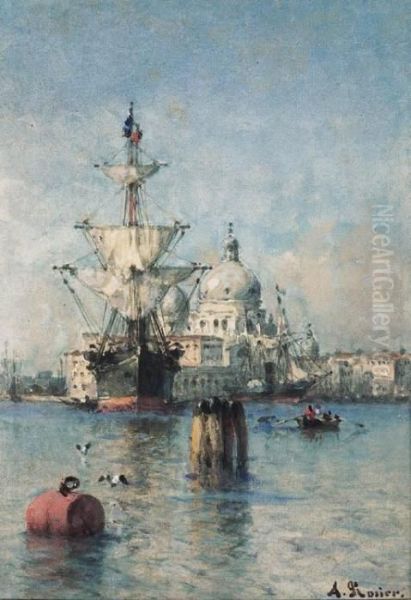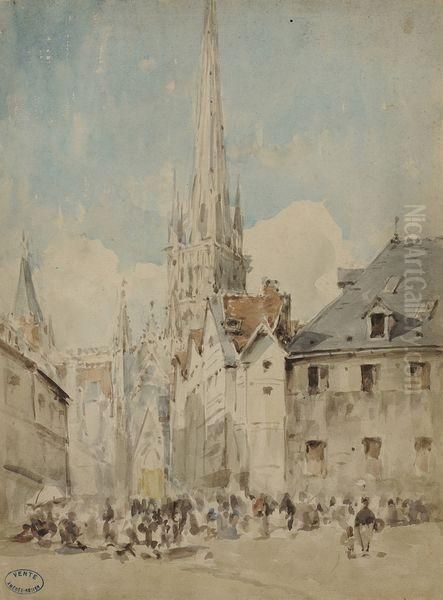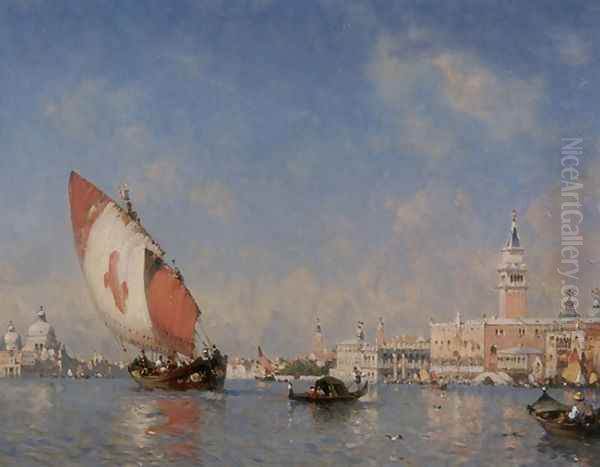
Amédée Rosier stands as a notable figure within the rich tapestry of 19th-century French art. Born in Meaux, France, in 1831, Rosier carved a distinct niche for himself primarily as a painter of luminous Venetian cityscapes and evocative Orientalist subjects. His career unfolded during a period of immense artistic ferment in Paris, witnessing the entrenchment of Academic traditions, the rise of Realism, and the revolutionary emergence of Impressionism. While perhaps not achieving the household name status of some contemporaries, Rosier developed a recognized and appreciated body of work, celebrated for its atmospheric depth and technical finesse. He passed away in 1898, leaving behind a legacy tied intrinsically to the sun-drenched canals of Venice and the exotic allure of the East.
Early Life and Artistic Formation
Details surrounding Amédée Rosier's earliest years remain relatively scarce, a common fate for artists operating just outside the brightest spotlights of fame. However, it is firmly established that he was born in 1831. His artistic inclinations led him to seek formal training in Paris, the undisputed center of the Western art world at the time. This was a crucial step for any aspiring painter seeking recognition and a career through the established Salon system.
Rosier's artistic education placed him under the tutelage of respected masters. He studied with Léon Cogniet, a prominent painter known for both historical scenes and portraits, straddling Neoclassical clarity and Romantic expressiveness. Cogniet's studio was a significant training ground, attracting numerous students who would go on to make their mark. Rosier also learned from Charles-Émile-Auguste Durand, better known as Carolus-Duran. Carolus-Duran, himself influenced by the realism of Gustave Courbet and the painterly techniques of Diego Velázquez, was a highly sought-after portraitist and teacher, later instructing figures like John Singer Sargent. This combination of influences likely provided Rosier with a solid grounding in academic drawing and composition, alongside an appreciation for capturing likeness and perhaps a freer approach to brushwork than strict Neoclassicism might dictate.
The Salon Debut and Early Career

The Paris Salon, the official exhibition of the Académie des Beaux-Arts, was the paramount venue for artists seeking public recognition, critical appraisal, and potential patronage. A successful debut at the Salon could launch a career. Amédée Rosier achieved this critical milestone in 1857. He presented his painting, Combat naval avant Sébastopol (Naval Combat before Sevastopol), a work likely inspired by the recent Crimean War (1853-1856).
The choice of a contemporary military subject, particularly a naval scene, demonstrated ambition. Such themes often required complex compositions, dynamic action, and meticulous detail. The positive reception of this work at the Salon marked Rosier's arrival on the Parisian art scene. It brought him visibility and established his credentials as a capable artist, paving the way for future submissions and the gradual development of his signature themes. While specific critical reviews from 1857 might be elusive today, the fact that this debut is consistently noted in biographical accounts underscores its importance in launching his professional life.
The Enchantment of Venice
While his debut featured a military scene, Amédée Rosier became most profoundly associated with the city of Venice. Like countless artists before and after him, from Canaletto and Francesco Guardi in the 18th century to J.M.W. Turner, James McNeill Whistler, and Félix Ziem in his own century, Rosier fell under the spell of La Serenissima. The city's unique interplay of water, architecture, and light offered endless inspiration.
Rosier's Venetian canvases capture the city's iconic landmarks and its more intimate corners. Works such as View of Venice, View of St. Mark's Square, Venice Lagoon by Moonlight, and Le Jardin Français, The Balustrade, Venice showcase his dedication to the subject. He was particularly adept at rendering the distinctive Venetian atmosphere – the shimmering reflections on the canals, the hazy sunlight diffusing through the humid air, and the dramatic effects of moonlight on the water and buildings.
His approach often combined topographical accuracy with a heightened sense of mood. Unlike the crisp, detailed vedute of Canaletto, Rosier's Venice often feels more painterly and atmospheric, perhaps absorbing some ambient influence from the burgeoning Impressionist interest in light, even if his style remained fundamentally rooted in a more traditional vein. He captured the grandeur of the Grand Canal and St. Mark's Basilica, but also the quiet charm of smaller waterways and secluded gardens, often featuring the characteristic gondolas that animate the city's liquid streets.
Exploring Orientalist Themes

Alongside his Venetian scenes, Orientalism formed the other major pillar of Amédée Rosier's oeuvre. The 19th century saw a widespread fascination in Europe with the cultures, landscapes, and peoples of North Africa, the Middle East, and Asia – a phenomenon collectively known as Orientalism. This interest was fueled by colonial expansion, increased travel, and romanticized notions of the "exotic." Artists like Eugène Delacroix, Jean-Léon Gérôme, Eugène Fromentin, and even the Neoclassical master Jean-Auguste-Dominique Ingres (in works like La Grande Odalisque) contributed significantly to this genre.
Rosier actively participated in this trend. His interest was not merely academic; sources indicate he traveled, particularly to North Africa and absorbing the atmosphere of Constantinople (modern-day Istanbul). These journeys provided firsthand material for his paintings, lending them a degree of authenticity, though inevitably filtered through a European lens. His Orientalist works likely depicted bustling marketplaces, serene mosques, desert landscapes, and scenes of daily life, imbued with the strong light and vibrant colors associated with these regions.
This aspect of his work placed him firmly within a popular and commercially viable genre. Orientalist paintings appealed to a European audience eager for glimpses into worlds perceived as dramatically different, often emphasizing sensuousness, mystery, and picturesque decay. Rosier's contribution focused on capturing the unique light and atmosphere of these locales, complementing his similar pursuits in Venice.
Artistic Style and Technique
Amédée Rosier's style is characterized by a blend of academic training and a sensitivity to atmospheric effects. His grounding under Cogniet and Carolus-Duran ensured a strong command of drawing, perspective, and composition. However, his primary interest lay in capturing the nuances of light and atmosphere, particularly in his favored Venetian and Orientalist subjects.
His brushwork, while generally controlled, could become looser and more suggestive when depicting water, sky, or the effects of light. He possessed a keen ability to render reflections on water, a notoriously difficult task, capturing the way light fractures and shimmers on the surface of Venice's canals or the Mediterranean coast. His palette often favored luminous blues, warm golds, and soft pinks, especially in his Venetian scenes, effectively conveying the city's unique light at different times of day, from bright midday sun to the ethereal glow of twilight or moonlight, as seen in Venice Lagoon by Moonlight.

In his Orientalist works, one might expect a richer, perhaps warmer palette, reflecting the intense sunlight of North Africa or the Middle East. Across both themes, his goal seemed to be not just documentation, but the evocation of mood and place. He excelled at creating a sense of depth and space, drawing the viewer into the scene. While primarily an oil painter, Rosier also worked in watercolor, as evidenced by works like Vue de la cathédrale de Rouen (View of Rouen Cathedral), demonstrating versatility across media.
Career Progression and Recognition
Following his successful 1857 Salon debut, Rosier continued to exhibit regularly, building his reputation over the ensuing decades. His specialization in Venetian and Orientalist scenes likely found a ready market among collectors who appreciated these popular themes rendered with skill and atmospheric sensitivity. The recurring appearance of his works at auction houses, both during his lifetime and posthumously, attests to a sustained level of appreciation and commercial viability. Titles like Lively Landscape and Venetian Balustrade appearing in auction records indicate the types of works that circulated among buyers.
His participation in exhibitions extended beyond the Paris Salon. For instance, his work was included in an exhibition titled "Venise au XIXe siècle" (Venice in the 19th Century) held at the museum in Carcassonne. This inclusion highlights his recognition specifically as a painter of Venetian subjects. While the provided information doesn't detail specific awards or honors beyond his initial Salon success, consistent exhibition and market presence suggest a solid, respected career within the French art establishment of his time. He navigated the art world successfully enough to maintain a practice focused on his preferred subjects for several decades.
Rosier in the Context of His Time
Amédée Rosier worked during a dynamic and transformative period in French art. He was a contemporary of artists associated with vastly different movements. The Realism championed by Gustave Courbet challenged academic conventions earlier in Rosier's career. The Barbizon School painters, such as Jean-Baptiste-Camille Corot and Jean-François Millet, focused on landscape and rural life with a new naturalism.
Most significantly, Rosier's mature career coincided with the rise and flourishing of Impressionism. Artists like Claude Monet, Pierre-Auguste Renoir, and Edgar Degas revolutionized painting with their focus on capturing fleeting moments, the effects of light and color, and scenes of modern life, often employing broken brushwork and painting en plein air. While Rosier shared the Impressionists' interest in light, his technique and subject matter remained more aligned with established traditions, particularly the picturesque landscape and Orientalist genres.

He also worked alongside highly successful Academic painters like William-Adolphe Bouguereau and Alexandre Cabanel, who dominated the official Salons with their polished mythological and historical scenes. Rosier occupied a space between the avant-garde and the strictly academic, finding success with well-executed, atmospheric paintings in popular genres. His relationship with his teachers, Cogniet and Carolus-Duran, connects him directly to the mainstream lineage of French art education. His focus on Venice and the East also aligns him with specialists like Félix Ziem, who similarly built a career on luminous depictions of these locales. The friendships and rivalries common in the era, like that between Honoré Daumier and Corot, or the complex relationship between Auguste Rodin and Camille Claudel, formed the social fabric of the art world Rosier inhabited, though specifics of his personal interactions remain largely undocumented.
Legacy and Conclusion
Amédée Rosier's legacy rests primarily on his skillful and atmospheric depictions of Venice and Orientalist subjects. He was an artist who found his niche and pursued it with dedication and technical proficiency. His paintings offer viewers evocative glimpses into two of the most romanticized and visually captivating subjects for 19th-century European artists and audiences. His ability to capture the unique qualities of light – the hazy glow of Venice, the bright sun of North Africa, the shimmer of moonlight on water – is a hallmark of his work.
While not an innovator on the scale of the Impressionists or a dominant figure of the Academic establishment, Rosier represents a significant current within 19th-century French art: the accomplished specialist who catered to prevailing tastes while maintaining a high standard of craftsmanship. His training under notable masters like Cogniet and Carolus-Duran provided him with a strong technical foundation, which he applied to subjects that clearly held deep personal resonance.
Today, his works are found in various museum collections and continue to be appreciated on the art market, valued for their beauty, atmosphere, and skillful execution. Amédée Rosier remains a testament to the enduring allure of Venice and the Orient in the Western artistic imagination, a painter who masterfully translated the light and mood of these celebrated locales onto canvas. His contribution enriches our understanding of the diversity and depth of French painting during a pivotal era.